The electric vehicle (EV) market is experiencing a period of unprecedented growth, driven by the increasing affordability of EVs and their ability to travel longer distances on a single charge. In 2024, global electric car sales topped 17 million, representing over 20% of all new cars sold worldwide. Forecasts for 2025 expect EV sales to exceed 20 million, or more than one-quarter of all new vehicle sales globally. The momentum continues into 2025, with EV sales expected to exceed 20 million. This surge in popularity is not just a fleeting trend but a fundamental shift in the automotive industry, signaling a move towards sustainable transportation.
One of the primary factors fueling this boom is the decreasing cost of EVs. As battery technology improves and production scales up, electric cars are becoming more affordable than ever. Several governments worldwide offer tax credits, rebates, and incentives for purchasing electric vehicles, making them even more accessible. The competition among vehicle manufacturers has resulted in more diverse EV options, greater affordability and improved consumer sentiment. For example, in the UK, every new EV on the list now costs less than £24,000, and that's the first time that has ever happened. Plus, you can even get an electric SUV suitable for families within that price.
Another critical aspect driving EV adoption is the increasing range of these vehicles. Just about a decade ago, many people were worried about driving more than 200 km in an electric vehicle. Official figures back then barely reached an average range of 211 km in 2015. But through innovation and research, that average climbed to 338 km by 2020, and today some models comfortably top 500–600 km. This impressive progress owes much to improvements in battery energy density and increasingly aerodynamic designs. Modern EVs can travel farther on a single charge than many drivers travel in a typical week. Combined with charging infrastructure that continues to expand and improve, the electric vehicle proposition has never been stronger. In 2025, range has reached new heights, sometimes exceeding 800 km!
Several countries are leading the charge in EV adoption. China continues to be the EV powerhouse. In the first quarter of 2025, BEV sales surged by 55% compared to the same period last year, setting a record for any first quarter. The market continues to be boosted by a series of government measures, including the expansion of the trade-in scheme which offers financial incentives that encourage consumers to upgrade to newer vehicles. Europe is also experiencing healthy signs of electrification, especially in Spain and Italy. The European EV market has grown by 27% in the opening five months of the year, reaching 1.6 million units sold. Germany's EV sales are now at 45% growth YTD and the UK at 32% growth YTD. The North American EV market (US, Canada, and Mexico) has grown by 3% YTD in 2025, with the Canadian market holding back the region as it has fallen by ~20% YTD due to the pausing of EV subsidies earlier in the year.
Looking ahead, the EV market is expected to continue its upward trajectory. With ongoing advancements in battery technology, charging infrastructure, and government support, EVs are poised to become the dominant mode of transportation in the coming years. The race for ever-greater range is far from over. Some manufacturers are already developing batteries exceeding 110 kWh and using cells with higher energy density. Their goal is to offer ranges of 900 or even 1,000 km, all while keeping vehicle weight in check and limiting the environmental impact of battery production. Aerodynamic designs are becoming the norm, which should push many models above 600 km of range—even in more affordable segments. Finally, ultra-fast charging is gaining ground, with some stations surpassing 400 kW.

















